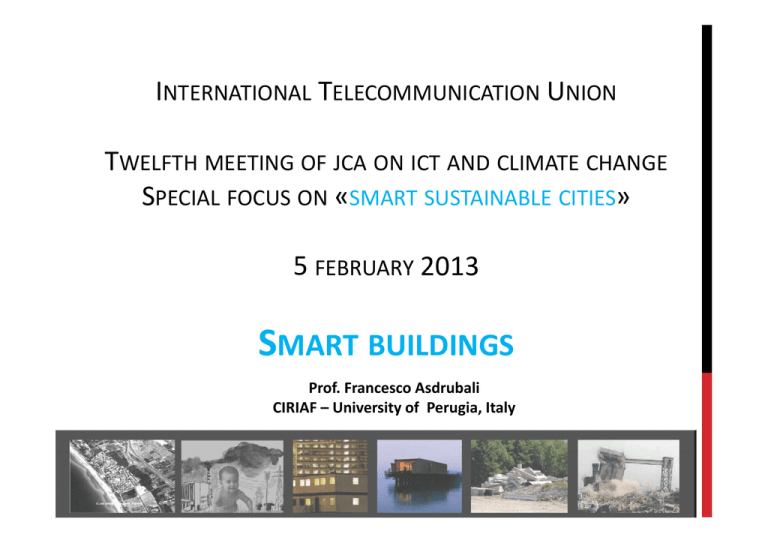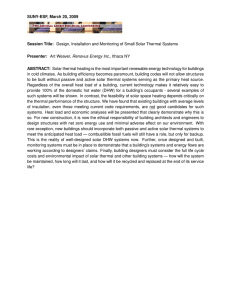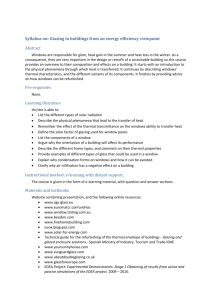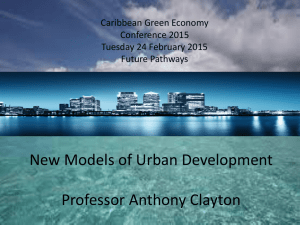I T U S
advertisement

INTERNATIONAL TELECOMMUNICATION UNION TWELFTH MEETING OF JCA ON ICT AND CLIMATE CHANGE SPECIAL FOCUS ON «SMART SUSTAINABLE CITIES» 5 FEBRUARY 2013 SMART BUILDINGS Prof. Francesco Asdrubali CIRIAF – University of Perugia, Italy Energy efficient buildings Reduction of energy demand: Improved thermal insulation, thermal storage, winter solar heat gains, passive heating and cooling, control of solar irradiation during summertime... Integration of renewable energies Solar energy, wind energy, low enthaply geothermal energy, biomass….. More efficient machineries and plants High efficiency boilers, Heat pumps, cogeneration, trigeneration, mechanical ventilation with heat recovery, efficient lighting systems.. Large use of ICT for control, regulation and monitoring of all the functions and systems ZEB NZEB Zero‐energy building (ZEB) is non grid connected building fully matching its annual energy needs/consumption by on‐site generation fully based on renewables. Net‐zero energy building (NZEB) is a grid connected, energy efficient building that balances its total annual operating energy needs /consumption and associated carbon emissions by on‐site feed‐in credits. Focus of the on‐site generation is matching the on‐site load. Nearly net ZEB: buildings that consume slightly more energy than they produce. Net plus energy buildings: buildings that produce a surplus of energy over the year. Definition of smart building SMART BUILDING development focuses on: •Identifying responsible practices in site location and materials selection for new construction; • Defining and incorporating intelligent information infrastructure into the building architecture; •Developing simple, flexible, and scalable network systems for buildings; •Incorporating power‐management for network systems INNOVATIVE INSULATING MATERIALS (Lightweight Expanded Clay Aggregate) Thermal insulating materials‐ Embodied energy Embodied energy MJ/UF 700.0 600.0 Sisal fibres MJ/UF 500.0 400.0 Some natural materials, such as cellulose flocks or cotton, show very low values of Embodied Energy, while expanded polyethylene or polyurethane exhibit the highest values. 300.0 There are also some natural materials (wood fibres) whose embodied energy is as high as that of synthesised materials. 200.0 100.0 0.0 Kenaf fibras VIP (Vacuum insulation panels) Bamboo fibres Reflective materials Materials produced from recycled PET INNOVATIVE TRANSPARENT MATERIALS AND COMPONENTS Emerging smart glass technology can dynamically change optical properties, and can be activated manually or by automated control systems. In all of these cases electric lighting should be controlled to meet occupant needs, while maximizing energy efficiency and minimizing electric demand. Terracotta solar shadings Metal sunshades Perforated metal sunshades Photovoltaic sunshade ALBEDO CONTROL A cool roof is a roof system characterized by high albedo properties, that make it able to reflect the solar radiation incident on its surface, combined to an as much high infrared emissivity, that allows the roof to emit the maximum quote of solar radiation previously absorbed, through thermal radiation. Such roof system allows to achieve several energy‐ environmental benefits, both direct effects on the building energy balance, and indirect effects, at urban scale and in terms of global climate. GREEN ROOFS AND WALLS Space constraints have further reduced the applicability of green surfaces in various areas surrounding the building envelope. Consequently, planted roofs become a promising choice in the present scenario. Good thermal protection can greatly reduce the high thermal loads that badly affect the comfort conditioning of building during summers. Planted roofs contribute not only in reducing the thermal loads on the building’s shell but also in reducing urban heat island effects in densely built areas having a little natural environment. For their biological functions such as photosynthesis, respiration, transpiration and evaporation, the foliage materials absorb a significant proportion of the solar radiation. Thermal protection techniques of green roof can provide a great degree of reduction in the local air temperature near canopy, thus reducing the incoming heat flux into the building. [Rakesh Kumar, S.C. Kaushik, Performance evaluation of green roof and shading for thermal protection of buildings, Building and Environment 40 (2005) 1505–1511] HIGH‐EFFICIENCY PLANTS Cogeneration (also combined heat and power, CHP) is the use of a heat engine or a power station to simultaneously generate both electricity and useful heat. Trigeneration Heat pumps PV PLANTS SMALL‐SIZE WIND TURBINES NATURAL LIGHTING Tubular Daylighting Devices (TDDs) use modern technology to transmit visible light through opaque walls and roofs. The tube itself is a passive component consisting of either a simple reflective interior coating or a light conducting fiber optic bundle. It is frequently capped with a transparent, roof‐mounted dome 'light collector' and terminated with a diffuser assembly that admits the daylight into interior spaces and distributes the available light energy evenly (or else efficiently if the use of the lit space is reasonably fixed, and the user desired one or more 'bright‐ spots'). Responsive building elements Building component/subsystems which are actively used for transfer and storage of heat, light, water and air. This means that construction elements (like floors, walls, roofs, foundation etc.) are logically and rationally combined and integrated with building service functions such as heating, cooling, ventilation and lighting. Dynamic and adaptive” concepts translate into the fact that functions, features and thermophysical behavior of such building components may change over the time and adapt to different building/occupants requirements (heating & cooling, higher/lower ventilation, …) and to different conditions lboundary (meteorological, internal heat / pollution loads, …). Outdoor climate Heat flux Responsive Building Elements Ventilation Energy storage Indoor climate Adaptive human comfort parameters Responsive building elements Phase change materials PCM are suitable materials characterized by the fact that, at the atmospheric pressure, they undergo a phase change in a range of temperatures around the ambient temperature. The basic principle is to exploit their considerable capacity of accumulating heat at temperatures close to their melting point. In fact, as long as the phase change is under way, heat is stored and released without any sensible temperature variation of the medium. This property can be used as a means of increasing the thermal inertia (thermal mass) of the building components and, therefore, to smooth the cooling/heating loads. THE ROLE OF LCA Life Cycle Assessments (LCA) procedures applied to buildings become extremely interesting, in order to evaluate energy consumptions and global impacts of various solutions, and to propose energy efficient design criteria. LCA procedures are widely known and applied to many products and technological cycles, but not yet sufficiently used in the building sector, at least in Italy. CASE STUDY ‐ RESIDENTIAL BUILDING Est façade Sud façade LCA of an independent house. The considered building has been designed according to standard insulation criteria of the Italian regulations. Operating phase 76% Construction 22% N End of life 1% LCA method Unit Damage Ecoindicator 99 H/H Pt/year 2911 CED MJ‐eq/year 538.335 IPCC Kg CO2/year 34.328 First floor plan THE ROLE OF LCA Scope of the ICT for energy efficient buildings vision [European Strategic Research Roadmap to ICT enabled Energy‐Efficiency in Buildings & Construction, ICT Supported Energy Efficiency in Construction Strategic Research Roadmap and Implementation Recommendations. ISBN 978‐951‐38‐7432‐2] The relevance of ICT on the energy efficiency of buildings is mainly as follows: • Short term: Assuring compliance to regulated minimum energy performance levels in design and renovation stages. • Medium term: Decision support for life cycle cost/performance optimisation. Real time operation, control and user empowerment. • Long term: Holistic optimisation of built environments considering: energy generation and usage of individual buildings, energy balancing between buildings within a district, responding to grid load and feeding excess energy into the grid. New business models driven by whole life time performance. “only solutions which create the greatest synergies between energy efficiency, comfort and safety and security will be sustainable over the long term … solutions that turn buildings into living organisms: networked, intelligent, sensitive and adaptable.” THANK YOU FOR YOUR ATTENTION





